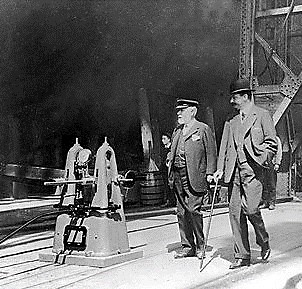

The story of the RMS Olympic began over a dinner in early 1907. Joseph Bruce Ismay, accompanied by his wife went to dine at Downshire House, Belgrave Square in London. They met Lord Pirrie, who had become Chairman of Harland and Wolff Shipbuilders in 1896, and his wife.
The topic of conversation over dinner were the two remarkable new liners: Lusitania and Mauretania. Both were owned by their rival company, the Cunard Line. Ismay raised the concept of bigger and more luxurious ships in order to surpass this competition.
Due to the nature of the industry, Harland and Wolff and the WSL had a close association. Harland and Wolff had constructed all the WSL ships.
After dinner, Ismay and Pirrie discussed the proposed construction of three sister ships: Titanic, Olympic and Gigantic. After the tragic loss of the Titanic, the name Gigantic was changed to Britannic. The Olympic and the Titanic would be nearly one and a half times larger than the Mauretania and the Lusitania. As a result, these three ships made the WSL prominent again in both transatlantic and world liner services.
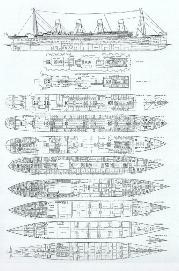
Rough drawings were made of the three ships, which envisaged each with two or three masts. The final plans added a fourth “dummy funnel” for ventilation but the ships would only have two masts. The chosen names ascribed the three ships as being mighty, powerful: the biggest the world had ever seen. Whilst safety, luxury and comfort were the essential features throughout the plans, all three ships would have to be capable of significant speed.
It was Ismay's job to secure finances. Early in 1908, the WSL issued £2,500,000 of additional shares to cover the bulk of the estimated £3 million costs. Together with the profits for the year 1909 exceeding £1 million, it was only a matter of time before the project could start.
By the end of July 1908, the directors of the WSL examined the final designs for the two ships. An agreement with Harland and Wolff was signed on 31 July. It was a historical day for the WSL.
Whilst Ismay and Pirrie had conceived the idea of the three giants, the general responsibility of the design was delegated to Alexander Montgomery Carlisle, General Manager at Harland and Wolff and Lord Pirrie's brother-in-law.
Lord Pirrie approached the shipbuilders John Brown & Co for the supply of steel, and to secure the use of new turbine technologies far more advanced than theirs. The Mauretania had already taken advantage of these new technologies and achieved unsurpassed speeds. The “Olympic class” ships should average 21 knots.
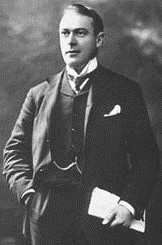
Lord Pirrie's nephew, Thomas Andrews (1873-1912), the distinguished Naval architect, was in charge of design. He was the Managing Director of Harland and Wolff’s Design Department. See Titanic Personalities for Thomas Andrews’ biography.
By 1908, he was at the height of his powers. He prepared the scale drawings that would enable work to start.
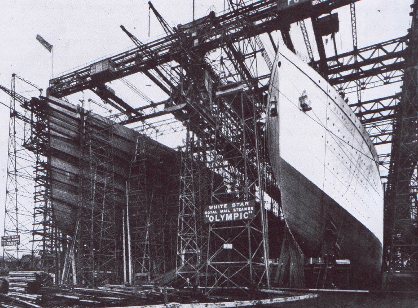
The shipbuilders were faced with the problem of how to build ships of unprecedented size. Since 1853, Harland and Wolff had employed 14,000 workers to build a staggering nine ships at any one time. Even the keels of the larger ships were small compared to the giants they were about to build. No slipways in the world could yet accommodate the Titanic and her sisters.
Construction began on a giant gantry and slipway called the “Great Gantry” or the “Arrol Gantry” after its builders, Sir William Arrol & Co, Glasgow. It stood 228 feet high, 270 feet wide and 840 feet long, and weighed more than 6,000 tons. 10 cranes transported men and material to the different levels of construction. The Great Gantry cost £100,000. The crane cost £30,000 and was specially imported from the German Benrather Company to handle the large loads necessary to fit out each ship following its launch.
The Olympic was 882.6 feet long with a beam of 92.6 feet and the Titanic was 882.9 feet long with a beam of 92.6 feet. Each had a gross tonnage of over 45,000. They would be the biggest ships afloat.
On 1 July 1907, the order was given to commence work on two of the sisters. The Olympic was given shipyard number 400 and the Titanic was given 401. The ships would be constructed in the traditional method of keel, frame and shell plating built up of riveted sections. The stern frame had a total complete weight of 70 tons but would be increased by another 73.5 tons once the propeller shafts had been added. The centre anchor weighed 50.5 tons.
The keel of the Olympic was laid on 16 December 1908 and she was framed by 20 November 1908. On 31 March 1909, keel 401, the Titanic, was laid on the adjacent slipway. The Olympic’s shell plating was completed by April 1910 and she was launched on 20 October 1910. She was completed by the end of May 1911. The Titanic was launched on 31 May and completed by 2 April 1912.
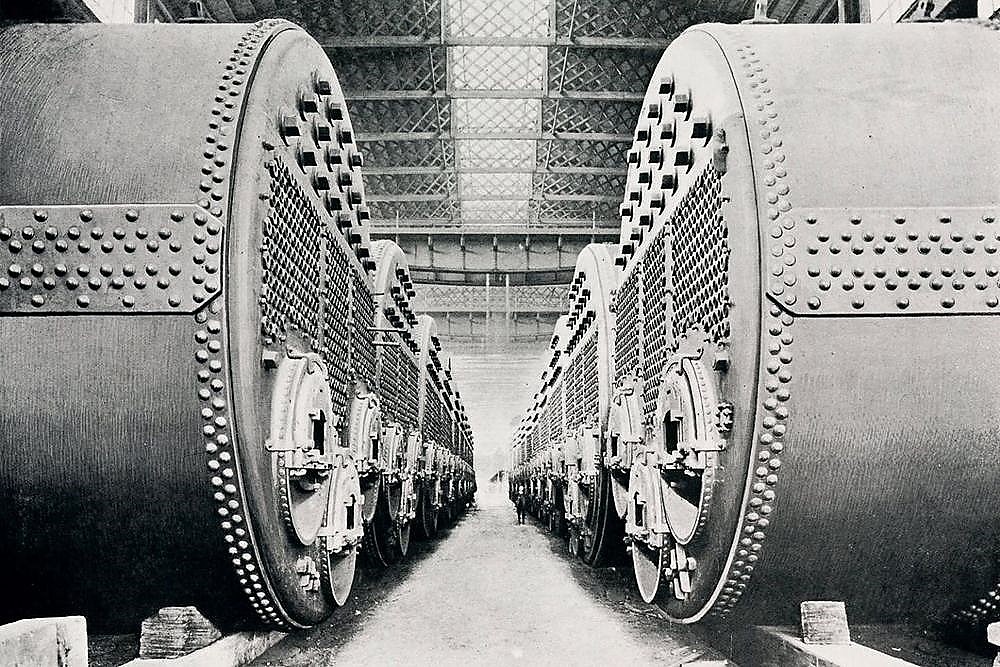
Triple screw engines were needed to propel a 46,000 ton ship. The engines of the “Olympic class” liners stood four decks high housed in six compartments. In all there were 29 boilers supplied by 159 furnaces generating pressures up to 215lbs per square inch.
As construction of the Titanic and the Olympic continued, it was evident that the ships with an overall length of 882 feet, were too long for the River Test in Southampton. The Southampton Dock Company would have to rebuild one of the wharfs to accommodate the new ships.
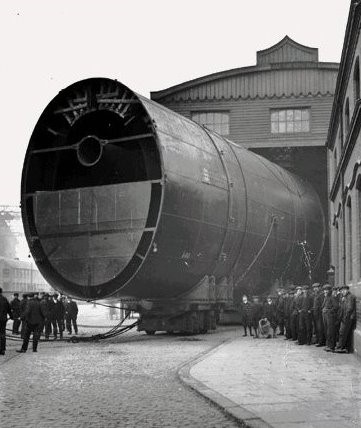
The four funnels were an elliptical shape and were 24 feet 6 inches high by 19 feet long. The fourth funnel was a dummy to provide a balanced appearance.
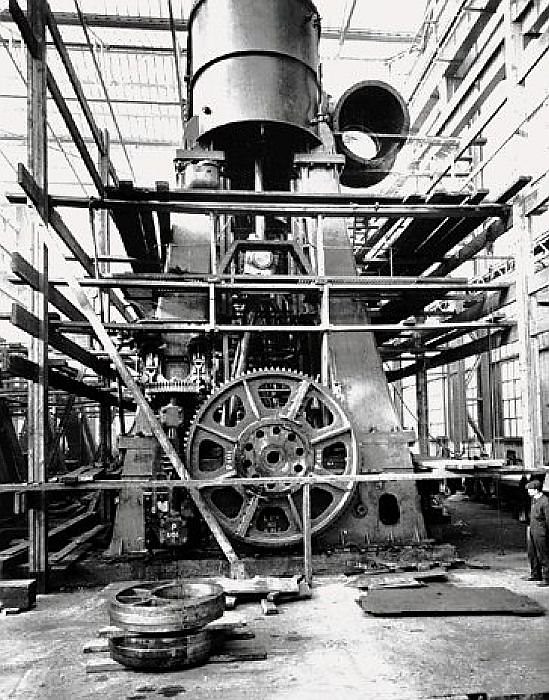
By October 1910, the Olympic's grey hull was complete and on Thursday 20 October, was launched at Belfast. Officials stared in amazement at her size as she slid into the water. It took only 62 seconds to launch the huge 20,600 ton hull.
As she slipped away, the giant hull of the Titanic was slowly revealed to the special guests who included the Lord Lieutenant of Ireland and the Lord Mayor of Belfast.
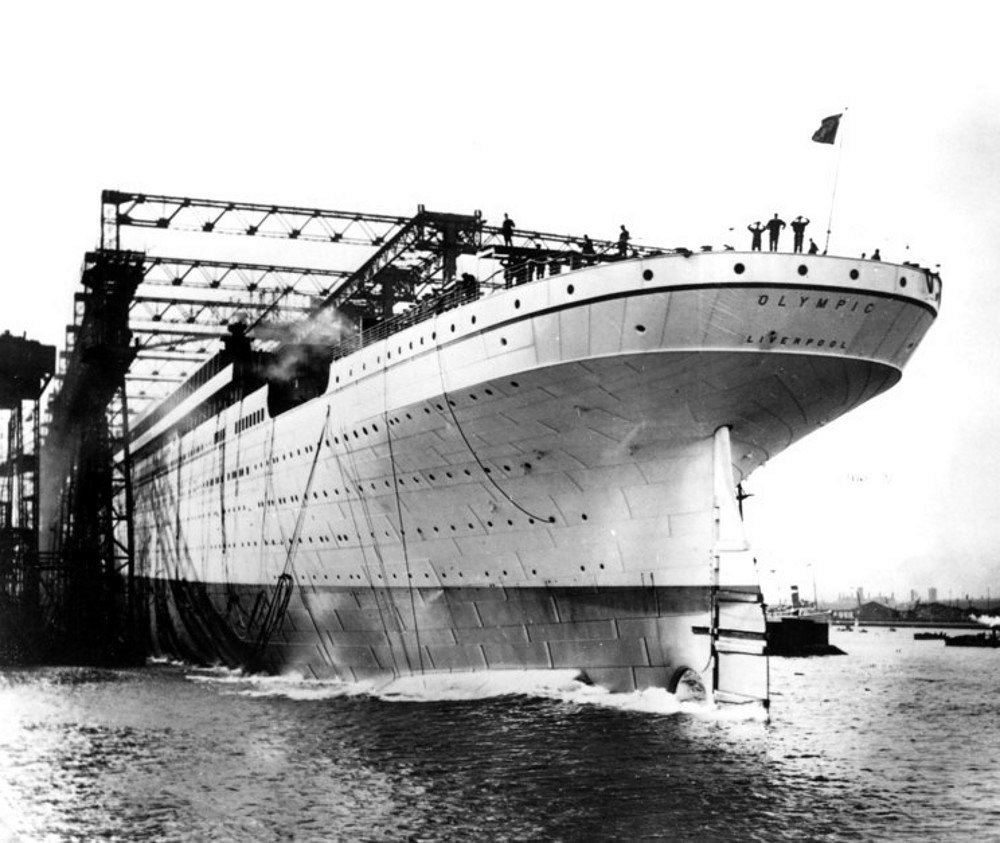
The Olympic began her fitting out. The £30,000 crane from Germany was used to place the funnels amongst other things. After fitting out, she was dry docked in the newly completed Thompson Graving Dock (designed especially for the new generation of giants).
On 1 April 1911, the propellers were fitted. It took until 29 May 1911, to transform the hollow hull into a floating palace which thousands of people would admire for over two decades. On that day, the Olympic sailed down Belfast Lough to undergo her two-day sea trials.
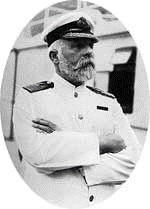
On 31 May 1911, the Olympic left Belfast bound for Liverpool to be registered. On the very same day, the Titanic was launched from slip way No. 3 attracting a crowd of over 100,000. After her launch, the VIP guests were taken on board the Olympic.
It would have been a glorious day for the WSL. Not only could the guests witness the launch of the biggest ship in the world, they could also see the sister waiting fully fitted for duty.
At 4.30 p.m., Captain Edward J. Smith (pictured above) took the helm and steered the Olympic through Belfast Lough (accompanied by the Normadic and the Traffic, two passenger tenders constructed to aid the new liners) to Liverpool.
The Olympic was the first of three sisters and was fitted with the same styles and features found on the Titanic except for the Promenade decks which only ran half length.
On her maiden voyage, Ismay had noticed that the open deck space on B-Deck was too large and few passengers were using it. He rectified this by ordering the Titanic's plans to be changed; more cabins were added alongside the promenade deck thus creating extra passenger capacity. Most of the Olympic’s interiors were well photographed and some pictures were used whilst describing the inside of the Titanic (Go to Titanic interiors).